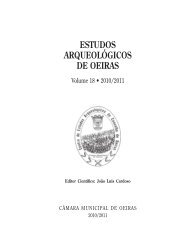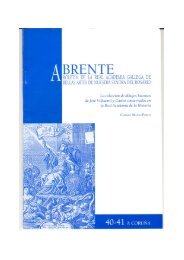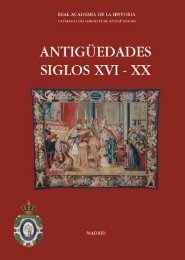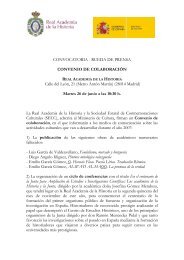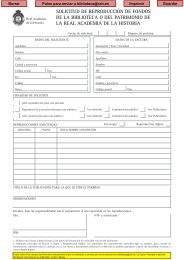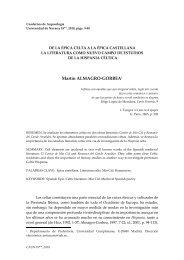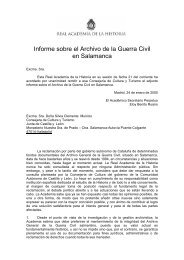Catál. Gabinete Monedas Griegas - Real Academia de la Historia
Catál. Gabinete Monedas Griegas - Real Academia de la Historia
Catál. Gabinete Monedas Griegas - Real Academia de la Historia
You also want an ePaper? Increase the reach of your titles
YUMPU automatically turns print PDFs into web optimized ePapers that Google loves.
MONEDAS GRIEGAS Introducción<br />
das enviadas por don Juan Francisco Martínez Falero 31 hal<strong>la</strong>das en <strong>la</strong>s excavaciones<br />
<strong>de</strong> Cabeza <strong>de</strong>l Griego, Segóbriga, entre <strong>la</strong>s que se encuentra una moneda <strong>de</strong> bronce<br />
griega, pero como no sabemos ni el peso ni <strong>la</strong> <strong>de</strong>scripción, cualquier i<strong>de</strong>ntificación <strong>de</strong><br />
el<strong>la</strong> a partir <strong>de</strong> estos datos resulta imposible.<br />
Algunas explicaciones o cierta pista sobre <strong>la</strong> ausencia <strong>de</strong> muchas <strong>de</strong> <strong>la</strong>s piezas<br />
<strong>de</strong> <strong>la</strong> Colección podrían hal<strong>la</strong>rse en dos cartas datadas en 1826, una <strong>de</strong> el<strong>la</strong>s en francés<br />
32 en <strong>la</strong> que se ofrece un intercambio <strong>de</strong> monedas griegas por españo<strong>la</strong>s, valoradas<br />
por el célebre numismático francés Theodore E. Mionnet, responsable <strong>de</strong>l <strong>Gabinete</strong><br />
<strong>de</strong> <strong>Monedas</strong> y Medal<strong>la</strong>s <strong>de</strong> <strong>la</strong> Biblioteca Nacional <strong>de</strong> Paris. La otra carta está <strong>de</strong>stinada<br />
a don Félix Torres Amat 33 <strong>de</strong>s<strong>de</strong> Constantinop<strong>la</strong>, en <strong>la</strong> que se informa <strong>de</strong>l interés<br />
que tiene el señor Burgart por hacerse con unas cuantas monedas españo<strong>la</strong>s y para<br />
ello se dirige a <strong>la</strong> <strong>Real</strong> <strong>Aca<strong>de</strong>mia</strong> <strong>de</strong> <strong>la</strong> <strong>Historia</strong> para tratar <strong>de</strong> intercambiar con el<strong>la</strong><br />
otras piezas griegas y romanas. No se conoce el remitente <strong>de</strong> <strong>la</strong> carta, pero el autor<br />
se ofrece para buscar piezas que interesen a <strong>la</strong> <strong>Real</strong> <strong>Aca<strong>de</strong>mia</strong> <strong>de</strong> <strong>la</strong> <strong>Historia</strong> durante<br />
su estancia en <strong>la</strong> capital otomana.<br />
El interés <strong>de</strong> <strong>la</strong> <strong>Aca<strong>de</strong>mia</strong> por engrosar <strong>la</strong> colección <strong>de</strong>l <strong>Gabinete</strong> Numario es<br />
constante durante estos años. Prueba <strong>de</strong> ello es el gran número <strong>de</strong> informes que localizamos<br />
en este segundo cuarto <strong>de</strong>l siglo XIX, en el que comenzará a emerger <strong>la</strong> figu-<br />
32 GN 1826/1(1).<br />
33 GN 1827/1(1).<br />
Figura 3.– Propuesta <strong>de</strong> adquisición <strong>de</strong> <strong>la</strong> colección <strong>de</strong> monedas y medal<strong>la</strong>s griegas<br />
<strong>de</strong> D. Dámaso Puerta y Álvarez, en 1827.<br />
27




